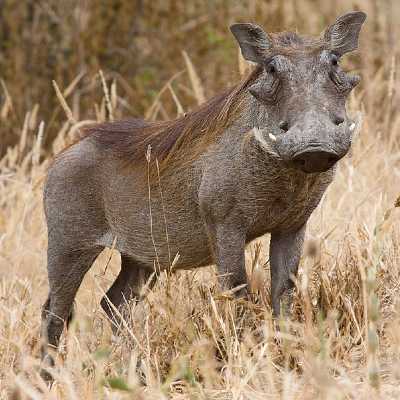 SKC Films Library SKC Films Library |
|
|
| SKC Films Library >> Science >> Zoology >> Mammals >> Order Artiodactyla >> Family Suidae |
| Warthog Phacochoerus africanus Description This member of the pig family is distinguished from its cousins by a disproportionately large head. There are also two large pairs of "warts" below the eyes, and between the eyes and the tusks, and a very small pair near the jaw (usually just in males). Those warts are actually just thick growths of skin, and even though they stick out they contain no bones or cartilage. The face is fairly flat and the snout elongated. Eyes set high on the head enables the warthog to keep a lookout for predators even when it lowers its head to feed on short grass. The two upper tusks emerge from the sides of the snout to form a semicircle; the lower tusks at the base of the uppers are worn to a sharp cutting edge. The warthog has longer legs than most other kinds of swine, allowing it to reach speeds of up to 34 miles per hour.
An adult warthog is 3-5 feet long, about 30 inches high, and weighs 110-250 pounds; males are heavier than females. Sparse bristles cover the warthog's body, although longer bristles form a mane from the top of the head down the spine to the middle of the back. The skin is gray or black. Distribution and Habitat Warthogs are found throughout most of sub-Saharan Africa, primarily on savanna woodland and grasslands; they are not found in rainforest, desert, or mountainous regions. They are the only pigs able to live in areas without water for several months of the year. By tolerating a higher-than-normal body temperature, the warthog is perhaps able to conserve moisture inside its body that might otherwise be used for cooling. Habits and Behaviors When water is available, warthogs drink regularly and enjoy wallowing in muddy places. As part of their grooming they also take sand baths, rub against trees and termite mounds, and let birds pick insects off their bodies. Warthogs are very skilled at adapting to new threats. For example, most warthogs prefer to forage during the light of the morning and early evening, but if they live in an area where they are hunted by people they switch to foraging at night. Instead of digging their own burrows, warthogs find abandoned aardvark holes or natural burrows for homes to raise their young, sleep, and hide from predators. They usually back into their burrows, so they can use their sharp tusks to scare off any animal that bothers them. The burrows also protect them from temperature extremes. Although they prefer to run from danger, warthogs are not afraid to fight, using their sharp lower canine teeth (which look like straight tusks) as weapons. When they move slowly, their tail hangs down, but when they run, their tail sticks up with the bushy tip hanging down. Sows are much more social than boars. They stay in groups of up to 40 together with their young, called piglets. The sows communicate with all sorts of grunts, chirrups, growls, snorts, and squeals, which can be greetings, threats, and warnings, among other things. They also like to rest close together and even groom each other. Reproduction Boars have the most obvious "warts," and the reason for these growths becomes most obvious at mating time. The boars push and ram each other with their head and their blunt upper tusks to see which is the most powerful. Fortunately, their warts act as pads to cushion the blows, so they rarely injure each other. Eventually, one boar gives up, and the other boar gets to mate with the sows. Gestation takes just under six months. Before giving birth to a new litter, the female chases away the litter she has been raising and secludes herself. These juveniles may join up with another solitary female for a short time before they go on their own. Female warthogs only have four teats, so litter sizes usually are confined to four young (although litters of up to eight have been recorded). Each piglet has its "own" teat and suckles exclusively from it. Even if one piglet dies, the others do not suckle from the available teat. Although the young are suckled for about 4 months, after 2 months they get most of their nourishment from grazing. Warthogs are sexually mature at 20 months, but are usually not large or strong enough to win a mating battle until about 4 years old. They can live up to 18 years in the wild. Diet Although primarily herbivorous, warthogs, like their domestic pig cousins, will eat just about anything, even dead animals. Their large snouts allow them to smell things underground that they might want to root for, and they often kneel down on their front legs and use their muscular snout to dig up dinner. They will even shuffle along in the kneeling position if there are plenty of tasty things in the area. Scientific Classification phylum Chordata SOURCES |
| SKC Films Library >> Science >> Zoology >> Mammals >> Order Artiodactyla
>> Family
Suidae This page was last updated on May 12, 2017. |
